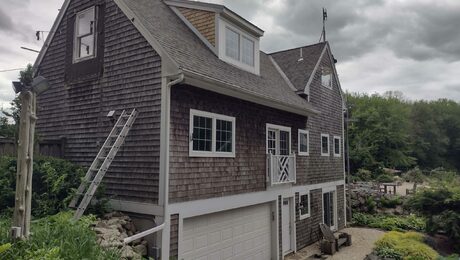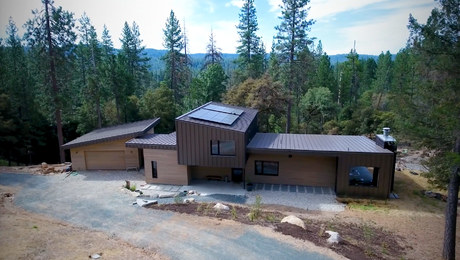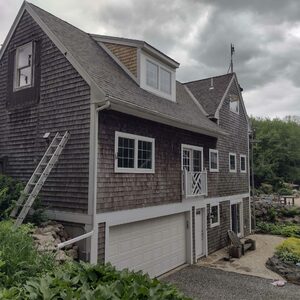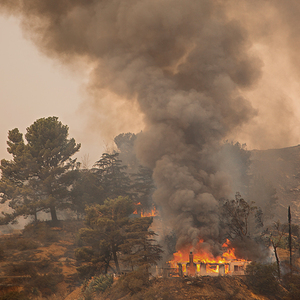New Build Water Service – What piping should I use in rural setting?
Hello all. I’m going to be installing my water service this fall but I not sure what is the recommended pipe to use. I have about 2800′ of water line to install (yes 2800 feet). Most people know pvc but I like the idea of fewer connection points with something like HDPE line. What you recommend using and why? Also, what sizing is best over this distance?
thanks,
Jason



















Replies
pex, we use 1" for our main
pex, we use 1" for our main but have never had to run anywhere near your distance. You shouldnt have a problem finding 1000' rolls at a plumbing supply house.
hdpe ok for your use, do check for 1000 ft rolls as suggested (not at big box)
plant a marker post at any junctionsor bends!
HDPE junction
How do the hdpe junctions work? Does HDPE pipe have to be "heat welded" / or are there fittings that will allow us to connect once at the county water service tap and then a temporary end cap or junction as needed depending on hdpe pipe length?
hdpe is fusion weld connections. pex have much simpler connections and much easier to work. specially if your going to get into anything larger that 3/4"
For a run that long it might be a good idea to run a marker wire with the pipe, similar to what they use for plastic gas lines. However, I don't know what termination schemes are used for such a wire (so they can actually be used when needed), so you'd have to check that out somewhere.
The only down sides to HDPE is the need to fusion weld any joints and the cost compared to pex.
Dig around for some hydraulic calculators to see what the pressure drop is going to be on a run that far. You may end up in 1.5" or bigger to get a usable pressure. You still may need another pump at the usage end.
Dig around for some hydraulic calculators to see what the pressure drop is going to be on a run that far. You may end up in 1.5" or bigger to get a usable pressure. You still may need another pump at the usage end.
pressure loss
Pressure loss due to friction through the tubing will be key. Over that length of run, your friction head loss will be pretty significant with tubing smaller than 2" in diameter..
You could go with a smaller diameter supply tube from street to house, and maybe add a holding tank at the house with a secondary pump to pressurize your domestic water. That way you'd get somewhat of a low psi, low flow "trickle supply" from the street to the house to fill your holding tank, then your secondary pressure pump could up the pressure to 40psi for domestic use.
Or you could up the size of the tubing so that the street pressure alone, even after accounting for friction head losses, will still provide you wth decent pressure at the house.
I'm not a plumber. So take the following more as idle chatter and something to look in to on your own rather than a directive from me. I preach no gospel on this topic.
In general, let's say you want 40psi usable pressure at the house. You'll aso need to figure your water usage or some sort of GPM requirement at the house. 30gpm is a fairly standard number.
I'm not positive that this is the correct table to refer to, but I'll throw it out for reference:
http://www.engineeringtoolbox.com/pressure-loss-plastic-pipes-d_404.html
The friction head loss per 100' of pipe for the different types of plastic (PVC/PE, etc) are pretty much the same, these numbers are for a 30gpm flow:
1.25" pipe, the loss is 11.8psi/100ft or 0.118psi/ft
1.5" = 5.6psi/100ft (0.056psi/ft)
2" = 1.7psi/100ft (0.017psi/ft)
2-1/2" = 0.7psi/100ft
3" = 0.2psi/100ft
For the 2800' run the friction head loss would then be:
1.25" pipe = 0.118 x 2800 = 330 psi loss
1.5" pipe = 0.056 x 2800 = 156 psi loss
2" pipe = 0.017 x 2800 ft= 48 psi loss
2-1/2" pipe = 19.6 psi loss
3" = 5.6 psi loss
Those numbers are simply for the water flowing through level pipe. If you have an elevation change in the run (house is higher or lower than the street) then that can work in your favor or to your detriment. Example, a 10' elevation change over the run of tubing can raise or lower your pressure by a little over 4 psi (approx), the number I'm using is 0.433 psi per foot.
With the rough numbers from above, if the town was supplying you with 80psi at the street, a 2" run of tubing over 2800' would theoretically give you 32psi at the house, a 2-1/2" would give 60psi, and a 3" run would give you 74psi at the house.
If the town has 50psi at the street, a 2-1/2" pipe will give you 30psi at the house, a 3" pipe 44psi at the house.
Fittings, elevation changes, etc, will skew them as well.
Those are simplified numbers for a very simplified theoretical discussion, and again, I'm not positive that my application of the numbers is correct.
whats he going to do tap into a fire hydrant? doubt the water company will allow a 3" tap and that much pressure coming out of the meter.
You make the tap with 3/4 or whatever the standard is in your area, then transition to the larger pipe for transport.
I am not sure I would design for 30 GPM tho. These days most fixtures are only rated at 3.
Ten might be a better number.
No clue how he'll hook it up. I was just trying to run some numbers for him.
Thanks for all of the help!
Thanks for all of the comments guys! I do know that I'll have a rather high 165psi at the tap (or close to it) and I have about a 70-75 foot drop by the time it finally reaches our site. It sounds like the 2" pipe is closer to what I need.
If you actually have 165psi at the main and the line will drop 75 feet to the structure, you probably want a pressure regulator at the service entrance.